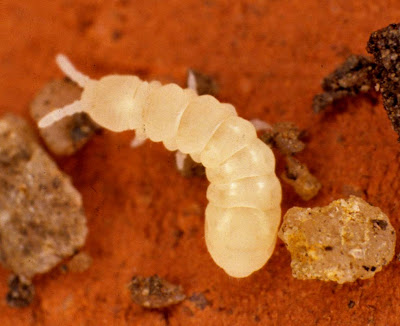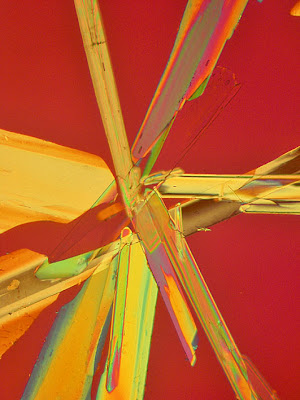Roots are the most neglected parts of plants, perhaps because they are out of sight and - superficially at least - lack the intrinsic aesthetic beauty of the above-ground parts. For most (although not all) plants they are vital structures and - when you look really closely - they have an intricate beauty of their own.

Root tips are sensitive gravity detectors, ensuring that the root always grows downwards into the soil. This root was held in the horizontal plane for less than an hour before it redirected its growth downwards. Behind the root tip you can see the point where the root hairs develop, with newly initiated root hairs just visible nearest the root tip but becoming longer as you move away from it. Further back still the root hairs die away continually and each has a life span of just a day or two, but they are continually replaced as the root penetrates further into the soil. The passage of the root through the soil is assisted by lubricating mucilage produced by the root tip, whose surface cells slough off. The mucilage also supports a bacterial microflora that helps the root acquire nutrients and may provide some protection from disease-producing organisms.

This is a root tip sectioned vertically and stained with a fluorescent dye called DAPI. If you click on the image to enlarge it the details will be a little clearer. The brightly fluoresescing dots are the nuclei, one per cell, and you can see the files of cells produced by sequential cell division followed by cell elongation, which pushes the root ever-further into the soil.

This is a root in transverse section, further back from the tip than the previous image, in the middle of the root hair zone. It has been stained with a fluorescent dye called calcofluor, which makes the cellulose cell walls fluoresce blue in ultraviolet light. From the outside inwards, you can see the long root hairs, each a single cell that arises from the root epidermis (surface layer of cells). Next inwards lies the root cortex, which constitutes the vast bulk of the cells, then in the centre you can see the stele - the cylinder of vascular tissue that transports water upwards to the rest of the plant and carries sugars and amino acides downwards to support the continued growth of the root.
The arrangement of the various cells and structures is more clearly visible here, at higher magnification. The large circles in the stele, top left, are xylem vessels that conduct water away from the root.
The root hairs, which are in intimate contact with the soil particles, absorb water and soluble minerals that are transported through the root cortex, both from cell-to-cell within cell cytoplasm (the symplastic route) and through cell walls and the spaces between cells (the apoplastic route), to the stele in the centre of the root.

Once the water reaches the stele it encounters a single layer of cells called the endodermis, that sheaths the stele. The walls of the endodermal cells contain a substance called suberin which renders them impermeable, so water that arrived via the apoplastic route is forced into and through the cytoplasm of these cells, where dissolved minerals are selectively removed. You can see the suberin deposits, known as the Casparian strip, as the orange staining in the single ring of cells that lies between the blue and the yellow cells in the section of a stele above. Some water also passes unimpeded through specialised passage cells in the endodermis - if you follow the ring of cells with the orange stained Casparian strip in their cell walls around the stele in the image above, you'll notice a few passage cells with no orange-stained suberin deposit in their walls. Almost all the water taken up and transmitted via both routes, via the cytoplasm of the endodemis cells or via their passage cells, then enters the dead xylem cells that carry it aloft in the water column that is drawn upwards by transpiration from the leaves.
When gardeners buy plants in garden centres there's a great temptation to simply dig a hole and plant them, without teasing out the pot-bound roots or cultivating the soil around the planting hole, but a little tender, loving care for root systems pays great dividends: the vigour of the plant above the soil depends on the health of the roots, hidden below the surface.






























































